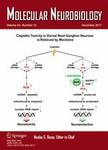版权所有:内蒙古大学图书馆 技术提供:维普资讯• 智图
内蒙古自治区呼和浩特市赛罕区大学西街235号 邮编: 010021

作者机构:Natl Yang Ming Univ Sch Med Dept & Inst Physiol Taipei 11221 Taiwan Natl Cheng Kung Univ Natl Cheng Kung Univ Hosp Dept Psychiat Coll Med Tainan 70101 Taiwan Natl Cheng Kung Univ Addict Res Ctr Tainan 70101 Taiwan Natl Cheng Kung Univ Taiwan Int Grad Program Interdisciplinary Neurosc Taipei Taiwan Acad Sinica Taipei Taiwan Natl Yang Ming Univ Brain Res Ctr Taipei 11221 Taiwan Taipei Med Univ Coll Med Sci & Technol PhD Program Neural Regenerat Med Taipei 11031 Taiwan
出 版 物:《MOLECULAR NEUROBIOLOGY》 (分子神经生物学)
年 卷 期:2018年第55卷第6期
页 面:4811-4824页
核心收录:
学科分类:1002[医学-临床医学] 1001[医学-基础医学(可授医学、理学学位)] 10[医学]
基 金:Ministry of Science and Technology of Taiwan [MOST 105-2628-B-010-006-MY3, MOST 104-2314-B-006-030-MY3, MOST 103-2321-B-010-016, MOST 99-2628-B-006-013-MY3] Yen Tjing Ling Medical Foundation, Taiwan [CI-105-12] National Yang-Ming University-Far Eastern Memorial Hospital Joint Research Program [NYMU-FEMH 106DN09] Brain Research Center, National Yang-Ming University Ministry of Education, Aim for the Top University Plan, Taiwan
主 题:Autism spectrum disorder (D)-Cycloserine Long-termdepression NMDARs GluA2/AMPARs Valproic acid
摘 要:Valproic acid (VPA)-exposed rat offspring have demonstrated autism spectrum disorder (ASD) phenotypes and impaired N-methyl-D-aspartate receptor (NMDAR)-dependent long-term depression (LTD) in the lateral nucleus of the amygdala. NMDAR partial agonist (D)-cycloserine (DCS) has been reported to act as a cognitive enhancer by increasing the NMDAR response to improve autistic-like phenotypes in animals. However, the mechanism of DCS in alleviating the ASD is still unknown. Using combined behavioral, electrophysiological, and molecular approaches, we found that DCS administration rescued social interaction deficits and anxiety/repetitive-like behaviors observed in VPA-exposed offspring. In the amygdala synapses, DCS treatment reversed the decreased paired pulse ratio (PPR) and the impaired NMDAR-dependent LTD, increased the frequency and amplitude of miniature excitatory post-synaptic currents (mEPSCs), and resulted in a higher dendritic spine density at the amygdala synapses in the VPA-exposed offspring. Moreover, we found that DCS facilitated the removal of GluA2-containing alpha-amino-3-hydroxy-5-methyl-4-isoxazolepropionic acid receptors (GluA2/AMPARs) by inducing NMDAR-dependent LTD in the VPA-exposed offspring. We further established that the effects of DCS treatment, including increased GluA2/AMPAR removal and rescues of impaired social behavior, were blocked by Tat-GluA2(3Y), a GluA2-derived peptide that disrupted regulation of AMPAR endocytosis. These results provided the first evidence that rescue of the ASD-like phenotype by DCS is mediated by the mechanism of GluA2/AMPAR removal in VPA-exposed rat offspring.